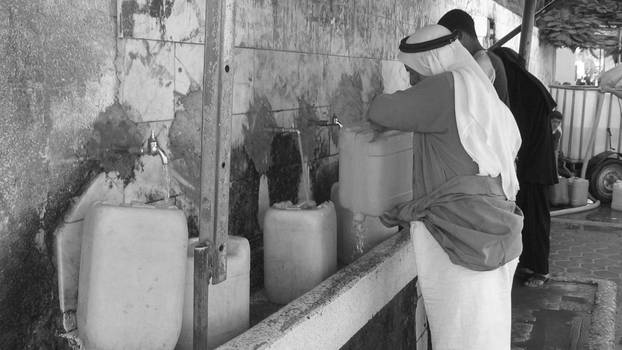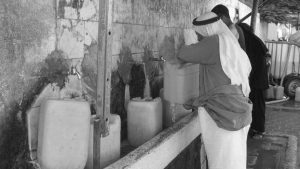Original text in German by Clemens Messerschmid
English translation by Katharina Konarek
The water shortage in the Gaza Strip is almost proverbial. Every child knows that the narrow coastline has too many people and too little water. At least that is the apparent certainty of almost all reports.
In 2012, A UN report predicted that Gaza would be uninhabitable in 2020. This conclusion mainly relied on the catastrophic situation of the water sector. According to the report, the (coastal) aquifer would become unusable due to over-salting as early as 2016, and irreversibly damaged by 2020. This analysis – by itself – is reason enough to address the water situation in Gaza.
Gaza: Uninhabitable Since 1948
Hardly anyone thinks of Gaza as an area that was once famous for its fresh springs. Alexander III of Macedonia (aka Alexander the Great) in the 4th century BC stopped by this particular spot during his conquests in order to recover. Even during the British Mandate in the early 20th century, Gaza was known for its productive agriculture, its vegetables, and its large citrus plantations that supplied Europe with export products.
However, all of this changed suddenly after 1947. The war of 1947-49, which in Arabic is called the “catastrophe” (Nakba), led to today’s malaise of the coastal strip. During this war, Israel gained its independence while the Palestinians lost their land and subsequently their water. Israel went on to annex 70% more land than it had been granted under the 1947 UN Partition Plan, and gradually displaced almost the entire indigenous Palestinian population, especially in the coastal plain area that the Gaza Strip verges on. Hundreds of thousands of Palestinians lost all of their property, and many of them fled to Gaza.
Due to the violent annexes, the former Gaza subdistrict under the British Mandate shrank from 1,111.5 km2 before the Nakba to half its size (555 km2) in 1949 and to less than a third (today’s 362 km2) in 1950. Above all, however, this meant massive expropriation of water: While the district still had a well production rate of 26.6 million cubic meters per year in 1947, only 3.1 million cubic meters remained in the narrow coastal belt. Gaza thus lost 89 percent of its previous water resources.
At the same time, the population tripled overnight from 84,500 people in 1948 to 240,000 people two years later: There was a catastrophic emergency for everything, especially for water. Nominally, people had less than 35 liters a day to use for all purposes, including trade, agriculture, and drinking water. For the newly arrived refugees in particular, this often meant less than 20 liters a day during the first weeks and months; it was a matter of bare survival.
Months turned into years, years into decades, and the problem remained the same, only deepening steadily. For 72 years (that is, since the Nakba), Gaza has been “uninhabitable” as the UN report predicts for 2020 – at least if one understands housing to be more than just survival. Sick, exhausted, humiliated, desperate and with no hope of improvement, the residents could survive “further” for another 20 or 50 years… but should they? Should we force them to do so?
The Occupation and its Consequences
In 1967, the Occupation came along and did two things in particular regarding this subject: First, Israel prevented much-needed Palestinian well drilling[1], but not as strictly and systematically as it did in the water-rich West Bank[2]. Second, Israel has systematically neglected its responsibilty as an occupying power in terms of building and developing water and sanitation infrastructure. Not a single modern (i.e. three-stage) treatment plant has been built for almost 40 years, while the few one- or two-stage plants were already hopelessly undersized when they were planned. With that said, Israel came up with a worldwide unique innovation, the so-called “Infiltration Lagoons,” which are artificially dug sewage ponds that were perforated on the bottom and thus conducted the hardly cleaned sewage directly into the sensitive shallow freshwater aquifer. This raised the pollution of the groundwater incredibly – as readable by the nitrate content. The underlying idea was that it would be better to systematically and actively contaminate Gaza’s only drinking water resource with heavily polluted wastewater than to get it into the sea, where it would also affect the surrounding (Israeli) beaches. This method has been used for decades.
Already by the beginning of the Oslo Interim period, in the mid-1990s, Gaza had long since become an “emergency.” At that point, all UN and donor organizations agreed upon this fact. Yet what has happened since then? Clearly, a growing population, more wells, increasing withdrawals and thereby rapidly falling groundwater levels that lead to the penetration of saltwater; not only sea water but also brackish water from Israel. As a result, and as it is generally known, less and less water is available in the Gaza Strip today, and the little water that remains is increasingly polluted[3].
Obviously, the water emergency in Gaza is neither new nor does it threaten a sudden qualitative change in 2016 or 2020. The plight in the water sector has existed since 1948, it existed in 1967, and also in 1987 when the First Intifada erupted. During the so-called Oslo peace process in the 1990s, the malaise continued to grow. Over the years, new commissions visited constantly and came to the same conclusion time and time again: There is too little water in Gaza for too many people.
Why the Catastrophic Water Emergency?
Many texts claim that Gaza is the most densely populated country in the world. This, however, is misleading: In 2005, when Israeli Prime Minister Ariel Sharon pulled his troops and settlers out of the Gaza Strip, the population was around 1.3 million people in an area of 362 km² – which corresponds exactly to the area of Munich. So why, unlike Munich, is Gaza not known for its high standard of living? Why is there a catastrophic water emergency? This is neither about the climate nor the population density, but it has to do with other purely political and, above all, artificial reasons. Conceptually, the mistake is to speak of Gaza as a country (or even a state). Gaza is not a country: From a purely technical point of view, the entire Gaza Strip, with an urbanization rate of 96%, is a city that is by no means at the top when globally compared to densely populated metropolises, but rather in the middle. This is why Gaza should also be viewed and treated as a city, especially in terms of planning and water management.
The Only Hermetically Sealed City in the World
The uniqueness of this city really comes to light: Gaza is the only city in the world that is hermetically sealed and without any external connection. There is not a single other city on the planet that could or should supply itself with water from its own urban area. Munich gets its water from the Alps, while New York acquires it from vast drinking water protection areas hundreds of kilometers away. No city can possibly supply water from its urban area; no city has to, and no city is expected to do so… aside from Gaza.
This is why almost all, including the most well-intentioned, plans for Gaza’s water sector go astray or literally fail. Gaza should be helped like any other city. At the heart of it, urban space relates to densely populated areas where there is industry, handicrafts and services, with a high level of labor productivity and normally also a concentration of education, vocational training, scientific research, technology and culture. But urban spaces have and need a rural environment, the so-called “hinterland” from which they get their resources, raw materials, food and water. This is the case for every city all over the world… except for Gaza.
Official plans state that Gaza should be made “independent,” which is like squaring the circle and, to put it loosely, it adds insult to injury. The UN report from 2012, for example, proposes short-term measures to recycle treated wastewater and to desalinate seawater on a smaller scale. In the long term, the report advocates the repair of water pipes, the completion of new sewage treatment plants, and desalination on a large scale. What nobody seems to notice, however, is that water pipes are only vessels; they are not the water itself. Wastewater can only be clarified and reused to the extent that it could previously be applied and used as fresh drinking water for domestic water consumption… but this is precisely what Gaza lacks. What remains are the mega-desalination plants as universal remedy, but they are completely unsuitable for a city like Gaza. They are also ecologically very problematic worldwide.
Gaza has to be Reconnected with the World
What Gaza and its people need is to finally be treated like any other city in the world. Which city would survive for even a day if all streets, all tracks, all ports or airports, even footpaths, were hermetically sealed off? Gaza must finally be reconnected to the world. In concrete terms for water, this means that Gaza must be supplied with water from the outside – much like the Israeli settlements, which are illegal under international law, have been until 2005. Israel prides itself on being a so-called water surplus economy; a country and a water sector with excess water. However, the water carrier ends right in front of Gaza. Like the water-rich West Bank, Gaza should finally be allowed to buy water from Israel on a large scale and as an immediate measure, not just in two or five years, but now. As for the political question of Palestinian water rights, those can be discussed after at least a minimum decent basic water supply is ensured.
Clemens Messerschmid has been living and working as a hydrogeologist in the Occupied Palestinian Territories (OPT) for 23 years.
Note: The original text has been published at the RLS West Asia Dossier:
https://www.rosalux.de/dossiers/westasien/
[1] At the same time, the Israeli settlements in the Gaza Strip received ten times more fresh water, both from separate settlement wells in the Gaza Strip and via long-distance lines from Israel (reliefweb.int, www.haaretz.com).
[2] This is due to simple strategic considerations: Gaza is in the lower reaches, so to speak downstream in the groundwater flow. No matter how much is drilled there, it has little impact on the well levels in Israel. On the other hand, groundwater is missing, which naturally flows from the West Bank into Israel when it is pumped out by Palestinian wells.
[3] Under the conditions in Gaza, only two substances can be measured regularly and across the board: chlorides indicate the increasing salinization, nitrates the increasing pollution from agriculture and especially wastewater, not least the infiltration of lagoons, in which the sewer has now seeped away completely unexplained.









